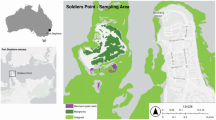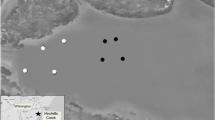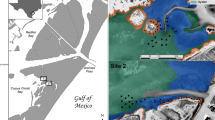Abstract
Eastern oysters (Crassostrea virginica) in Gulf of Mexico estuaries create complex reefs and provide important habitat for fish and crustaceans. Oyster reefs have suffered historic losses due to overharvest, disease, and degraded water quality, and recent efforts have focused on restoring reefs to benefit nekton populations. Oyster shell is the preferred substrate for oyster reef restoration, but as a consequence of its limited supply, a variety of alternative substrates are being used. We used field experiments to quantify the effects of substrate type (concrete, porcelain, limestone, river rock, and oyster shell) on oyster recruitment, growth, and nekton habitat use in St. Charles Bay, TX. After 4 months, oyster spat recruitment density, nekton density and community structure were similar across substrate types—and analogous to those on natural reefs—but differed from samples collected on bare sediment. To determine refuge value of the alternative substrates, we tested mud crab (Panopeidae) prey mortality with and pinfish (Lagodon rhomboides) or blue crab (Callinectes sapidus) predators. Prey mortality was similar across substrate types for both predators, and was significantly lower than no substrate and bare sand controls. Alternative substrates can provide important structural materials to support the development of oyster populations and nekton assemblages, and may be used to promote sustainable management of oyster reef resources via restoration.





Similar content being viewed by others
References
Airoldi L, Balata D, Beck MW (2008) The gray zone: relationships between habitat loss and marine diversity and their applications in conservation. J Exp Mar Biol Ecol 366:8–15
Asquith WH, Mosier JG, Bush PW (1997) Status, trends, and changes in freshwater inflows to bay systems in the CCBNEP study area. Corpus Christi Bay National Estuary Program, CCBNEP-17
Beck MW, Brumbaugh RD, Airoldi L, Carranza A, Coen LD, Crawford C, Defeo O, Edgar GJ, Hancock B, Kay MC, Lenihan HS, Luckenbach MW, Toropova CL, Zhang GF, Guo XM (2011) Oyster reefs at risk and recommendations for conservation, restoration, and management. Bioscience 61:107–116
Beseres Pollack J, Yoskowitz D, Kim HC, Montagna PA (2013) Role and value of nitrogen regulation provided by oysters (Crassostrea virginica) in the Mission-Aransas Estuary, Texas, USA. PLoS ONE 8:e65314
Beukers JS, Jones GP (1997) Habitat complexity modifies the impact of piscivores on a coral reef fish population. Oecologia 114:50–59
Boesch DF (1996) Science and management in four U.S. coastal ecosystems dominated by land-ocean interactions. J Coast Conserv 2:103–114
Brown L, Furlong J, Brown K, LaPeyre M (2014) Oyster reef restoration in the northern Gulf of Mexico: effect of artificial substrate and age on nekton and commensal community use. Restor Ecol 22:214–222
Brumbaugh RD (2000) An analysis of limestone marl as a settlement substrate for oysters in Chesapeake Bay. Virginia Marine Resources Commission Report
Brumbaugh RD, Coen LD (2009) Contemporary approaches for small-scale oyster reef restoration to address substrate versus recruitment limitation: a review and comments relevant for the Olympia oyster, Ostrea lurida Carpenter 1864. J Shellfish Res 28:147–161
Caldwell DK (1957) The biology and systematics of the pinfish, Lagodon rhomboides (Linnaeus). Bull Fla State Mus Biol Sci 2:77–174
Clarke KR (1993) Non-parametric multivariate analyses of changes in community structure. Aust J Ecol 18:117–143
Clarke KR, Gorley RN (2006) PRIMER v6: user manual/tutorial. PRIMER-E, Plymouth
Coen LD, Luckenbach MW (2000) Developing success criteria and goals for evaluating oyster reef restoration: ecological function or resource exploitation? Ecol Eng 15:323–343
Cooper SR, Brush GS (1993) A 2500-year history of anoxia and eutrophication in Chesapeake Bay. Estuaries 16:617–626
Crabtree R, Middaugh D (1982) Oyster shell size and the selection of spawning sites by Chasmodes bosquianus, Hypleurochilus geminatus, Hypsoblennius ionthas (Pisces, Blenniidae) and Gobiosoma bosc (Pisces, Gobiidae) in two South Carolina estuaries. Estuaries 5:150–155
Crisp DJ (1967) Chemical factors inducing settlement in Crassostrea virginica (Gmelin). J Anim Ecol 36:329–335
Dame R, Zingmark R, Stevenson H, Nelson D (1981) Filter feeder coupling between the estuarine water column and the benthic subsystem. In: Kennedy VC (ed) Estuarine perspectives. Academic, Waltham, pp 521–525
Duarte CM, Hendriks IE, Moore TS, Olsen YS, Steckbauer A, Ramajo L, Carstensen J, Trotter JA, McCulloch M (2013) Is ocean acidification an open-ocean syndrome? Understanding anthropogenic impacts on seawater pH. Estuar Coasts 36:221–236
Dunn RP (2013) Oyster demographics and Cliona boring sponge on potential reef-building substratesimplications for oyster restoration. MS Thesis, North Carolina State University, pp 93
Dunn RP, Eggleston DB, Lindquist N (2014) Effects of substrate type on demographic rates of Eastern oyster (Crassostrea virginica). J Shellfish Res 33:177–185
Eggleston DB, Elis WE, Etherington LL, Dahlgren CP, Posey MH (1999) Organism responses to habitat fragmentation and diversity: habitat colonization by estuarine macrofauna. J Exp Mar Biol Ecol 236:107–132
French-McCay DP, Peterson CH, DeAlteris JT, Catena J (2003) Restoration that targets function as opposed to structure: replacing lost bivalve production and filtration. Mar Ecol Prog Ser 264:197–212
Grabowski JH, Peterson CH (2007) Restoring oyster reefs to recover ecosystem services. In: Cuddington K, Byers JE, Wilson WG, Hastings A (eds) Ecosystem engineers: concepts, theory and applications. Elsevier-Academic Press, Amsterdam, pp 281–298
Grabowski JH, Powers SP (2004) Habitat complexity mitigates trophic transfer on oyster reefs. Mar Ecol Prog Ser 277:291–295
Grabowski JH, Hughes AR, Kimbro DL, Dolan MA (2005) How habitat setting influences restored oyster reef communities. Ecology 86:1926–1935
Gregalis KC, Johnson MW, Powers SP (2009) Restored oyster reef location and design affect responses of resident and transient fish, crab, and shellfish species in Mobile Bay, Alabama. Trans Am Fish Soc 138:314–327
Harding JM, Mann R (2001) Oyster reefs as fish habitat: opportunistic use of restored reefs by transient fishes. J Shellfish Res 20:951–959
Harvell CD, Kim K, Burkholder JM, Colwell RR, Epstein PR, Grimes DJ, Hofmann EE, Lipp EK, Osterhaus ADME, Overstreet RM, Porter JW, Smith GW, Vasta GR (1999) Emerging marine diseases—climate links and anthropogenic factors. Science 285:1505–1510
Hayes PR, Menzel RW (1981) The reproductive cycle of early setting Crassostrea virginica (Gmelin) in the northern Gulf of Mexico, and its implications for population recruitment. Biol Bull 160:80–88
Heck KL Jr, Thoman TA (1981) Experiments on predator-prey interactions in vegetated aquatic habitats. J Exp Mar Biol Ecol 53:125–134
Heck KL, Wetstone GS (1977) Habitat complexity and invertebrate species richness in tropical seagrass meadows. J Biogeogr 4:135–142
Hidu HS, Chapman S, Soule PW (1975) Cultchless setting of European oysters, Ostrea edulis, using polished marble. Proc Natl Shellfish Assoc 65:13–14
Hill JM, Weissburg MJ (2013) Habitat complexity and predator size mediate interactions between intraguild blue crab predators and mud crab prey in oyster reefs. Mar Ecol Prog Ser 488:209–219
Hosack GR, Dumbauld BR, Ruesink JL, Armstrong DA (2006) Habitat associations of estuarine species: comparisons of intertidal mudflat, seagrass (Zostera marina) and oyster (Crassostrea gigas) habitats. Estuar Coasts 29:1150–1160
Humphries AT, La Peyre MK, Kimball ME, Rozas LP (2011) Testing the effect of habitat structure and complexity on nekton assemblages using experimental oyster reefs. J Exp Mar Biol Ecol 409:172–179
Jones GP, McCormick MI, Srinivasan M, Eagle JV (2004) Coral decline threatens fish biodiversity in marine reserves. Proc Natl Acad Sci 101:8251–8253
Jordan F, Bartolini M, Nelson C, Patterson PE, Soulen HL (1996) Risk of predation affects habitat selection by the pinfish Lagodon rhomboides (Linnaeus). J Exp Mar Biol Ecol 208:45–56
Kellogg ML, Cornwell JC, Owens MS, Paynter KT (2013) Denitrification and nutrient assimilation on a restored oyster reef. Mar Ecol Prog Ser 480:1–19
Kirby MX (2004) Fishing down the coast: historical expansion and collapse of oyster fisheries along continental margins. Proc Natl Acad Sci 101:13096–13099
La Peyre M, Furlong J, Brown LA, Piazza BP, Brown K (2014) Oyster reef restoration in the northern gulf of Mexico: extent, methods and outcomes. Ocean Coast Manage 89:20–28
Mann R, Powell EN (2007) Why oyster restoration goals in the Chesapeake Bay are not and probably cannot be achieved. J Shellfish Res 26:905–917
Mann R, Barber BJ, Whitcomb JP, Walker KS (1990) Settlement of oysters, Crassostrea virginica (Gmelin, 1791), on oyster shell, expanded shale and tire chips in the James River, Virginia. J Shellfish Res 9:173–175
Nestlerode JA, Luckenbach MW, O’Beirn FX (2007) Settlement and survival of the oyster Crassostrea virginica on created oyster reef habitats in Chesapeake Bay. Restor Ecol 15:273–283
O’Beirn FX, Luckenbach MW, Nestlerode JA, Coates GM (2000) Toward design criteria in constructed oyster reefs: oyster recruitment as a function of substrate type and tidal height. J Shellfish Res 19:387–395
Orth RJ, Heck KL, van Montfrans J (1984) Faunal communities in seagrass beds: a review of the influence of plant structure and prey characteristics on predator-prey relationships. Estuaries 7:339–350
Pavesi L, De Matthaeis E (2013) Supralittoral amphipod abundances across habitats on Mediterranean temperate beaches. J Coast Conserv 17:841–849
Piazza BP, Banks PD, La Peyre MK (2005) The potential for created oyster reefs as a sustainable shoreline protection strategy in Louisiana. Restor Ecol 13:499–506
Pielou EC (1966) The measurement of diversity in different types of biological collections. J Theor Biol 13:131–144
Plunket J, La Peyre MK (2005) Oyster beds as fish and macroinvertebrate habitat in Barataria Bay, Louisiana. Bull Mar Sci 77:155–164
Polidoro BA, Carpenter KE, Collins L, Duke NC, Ellison AM, Ellison JC, Farnsworth EJ, Fernando ES, Kathiresan K, Koedam NE, Livingstone SR, Miyagi T, Moore GE, Nam VN, Ong JE, Primavera JH, Salmo SG, Sanciangco JC, Sukardjo S, Wang Y, Yong JWH (2010) The loss of species: mangrove extinction risk and geographic areas of global concern. PLoS ONE 5(4):e10095. doi:10.1371/journal.pone.0010095
Powell EN, Klinck JM (2007) Is oyster shell a sustainable estuarine resource? J Shellfish Res 26:181–194
Powell EN, Klinck JM, Ashton-Alcox K, Hofmann EE, Morson J (2012) The rise and fall of Crassostrea virginica oyster reefs: the role of disease and fishing in their demise and a vignette on their management. J Mar Res 70:505–558
Rozas LP, Minello TJ (1997) Estimating densities of small fishes and decapods crustaceans in shallow estuarine habitats: a review of sampling design with focus on gear selection. Estuaries 20:199–213
Runyan S (1961) Early development of the clingfish, Gobiesox strumosus cope. Chesap Sci 2:113–141
SAS Institute Inc (2012) Base SAS® 9.3 procedures guide, Second Edition. SAS Institute Inc, Cary
Scates C, Shook PH (1999) Fly fishing the Texas coast. Pruett Publishing Company, Boulder
Schulte DM, Burke RP, Lipcius RN (2009) Unprecedented restoration of a native oyster metapopulation. Science 325:1124–1128
Silliman BR, Bertness MD, Grosholz ED (2009) Human impacts on salt marshes: a global perspective. University of California Press, Oakland
Solis RS, Powell GL (1999) Hydrography, mixing characteristics, and residence times of Gulf of Mexico estuaries. In: Bianchi TX, Pennock JR, Twilley RR (eds) Biogeochemistry of gulf of Mexico estuaries. Wiley, New York
Soniat TM, Burton GM (2005) A comparison of the effectiveness of sandstone and limestone as cultch for oysters, Crassostrea virginica. J Shellfish Res 24:483–486
Soniat TM, Broadhurst RC, Haywood EL (1991) Alternatives to clamshell as cultch for oysters, and the use of gypsum for the production of cultchless oysters. J Shellfish Res 10:405–410
Stanley JG, Sellers MA (1986) Species profiles: life histories and environmental requirements of coastal fishes and invertebrates (Gulf of Mexico)–American oyster. U.S. Fish Wildl. Serv. Biol. Rep. 82(11.64). U.S. Army Corps of Engineers, TR EL-82-4, pp 25
Stunz GW, Minello TJ (2001) Habitat-related predation on juvenile wild-caught and hatchery-reared red drum Sciaenops ocellatus. J Exp Mar Biol Ecol 260:13–25
Stunz GW, Minello TJ, Rozas L (2010) Relative value of oyster reef as habitat for estuarine nekton in Galveston Bay, Texas. Mar Ecol Prog Ser 406:147–159
Waldbusser GG, Steenson RA, Green MA (2011) Oyster shell dissolution rates in estuarine waters: effects of pH and shell legacy. J Shellfish Res 30:659–669
Zu Ermgassen PS, Spalding MD, Blake B, Coen LD, Dumbauld B, Geiger S, Grabowski JH, Grizzle R, Luckenbach M, McGraw K, Rodney W, Ruesink JL, Powers SP, Brumbaugh R (2012) Historical ecology with real numbers: past and present extent and biomass of an imperiled estuarine habitat. Proc R Soc B Biol Sci 279:3393–3400
Acknowledgments
This study was funded by the Texas General Land Office Coastal Management Program contract number 13-041-000-6908, the Center for Coastal Studies, and the Hans and Pat Suter Scholarship Fund. Thanks to Dr. Paul Montagna and Dr. Lee Smee for helpful comments on earlier versions of this manuscript. Thanks also to B. Blomberg, A. Cohen, E. Diaz, J. Nevins, M. Rodriguez, R. Rezek, and G. Sutton, and staff at the Texas A&M AgriLife Mariculture Research Lab in Port Aransas, TX.
Author information
Authors and Affiliations
Corresponding author
Rights and permissions
About this article
Cite this article
George, L.M., De Santiago, K., Palmer, T.A. et al. Oyster reef restoration: effect of alternative substrates on oyster recruitment and nekton habitat use. J Coast Conserv 19, 13–22 (2015). https://doi.org/10.1007/s11852-014-0351-y
Received:
Revised:
Accepted:
Published:
Issue Date:
DOI: https://doi.org/10.1007/s11852-014-0351-y




